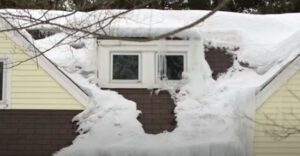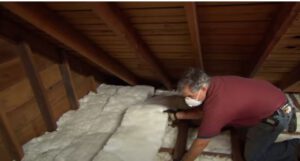While ice dams are commonly associated with colder regions, it is essential to understand that certain areas in Australia, particularly those in high-altitude regions and parts of Tasmania, experience freezing temperatures during winter. Ice dams are a result of snow or ice accumulating on the roof, leading to water backup and potential damage to the roof and interior of the house. In this article, we will explore effective strategies and preventive measures to help Australian homeowners prevent ice dams on their roofs during the winter season.
Understand the Causes and Effects of Ice Dams
 To effectively prevent ice dams, it is important to understand their causes and the potential damage they can cause. Ice dams form when warm air from the attic melts the snow on the roof, which then refreezes at the eaves where it is colder. This frozen mass prevents proper drainage, leading to water backup. The trapped water can seep under shingles, causing leaks, and may even result in structural damage or mold growth if left unattended.
To effectively prevent ice dams, it is important to understand their causes and the potential damage they can cause. Ice dams form when warm air from the attic melts the snow on the roof, which then refreezes at the eaves where it is colder. This frozen mass prevents proper drainage, leading to water backup. The trapped water can seep under shingles, causing leaks, and may even result in structural damage or mold growth if left unattended.
Improve Attic Insulation and Ventilation
One of the primary causes of ice dams is inadequate insulation and ventilation in the attic. A properly insulated attic prevents warm air from escaping into the roof, minimizing the chances of snow melting and refreezing at the eaves. Consider the following steps to improve attic insulation and ventilation:
- Insulate the attic floor: Install insulation materials, such as fiberglass batts or blown-in cellulose, to ensure that warm air from the living spaces does not rise into the attic.
- Seal air leaks: Identify and seal any gaps, cracks, or openings in the attic floor, ceiling, walls, and around chimneys, pipes, and vents. Use weatherstripping, caulk, or expanding foam insulation to create an airtight barrier.
- Install proper attic ventilation: Adequate ventilation allows for the exchange of air between the attic and the outdoors, regulating the temperature and humidity levels. Ensure that soffit vents and ridge vents are installed correctly to allow for proper airflow.
Clear Snow Regularly
Regularly removing snow from your roof can prevent the accumulation that leads to ice dams. However, it is essential to do this with caution to avoid damaging the roof. Consider the following tips when removing snow:
- Use a roof rake: Invest in a roof rake with a long telescopic handle to remove snow from the ground level. Carefully pull the rake down the roof, making sure not to damage shingles or gutters.
- Hire professionals: For larger roofs or if you’re uncomfortable performing the task yourself, consider hiring professionals who specialize in snow removal to safely clear the snow.
Create a Cold Roof Environment
Creating a cold roof environment helps to minimize the chances of snow melting and refreezing at the eaves. The following measures can help achieve this:
- Install eave or roof heat cables: These cables are designed to provide gentle heat to the eaves, preventing the formation of ice dams. Consult a professional for proper installation and usage guidelines.
- Increase insulation near the eaves: Install additional insulation materials, such as rigid foam or spray foam, near the eaves to prevent warm air from reaching these areas.
Ensure Proper Gutter Maintenance
 Maintaining your gutters and downspouts is crucial in preventing ice dams. Blocked gutters can lead to water backup, exacerbating the formation of ice dams. Consider the following steps for effective gutter maintenance:
Maintaining your gutters and downspouts is crucial in preventing ice dams. Blocked gutters can lead to water backup, exacerbating the formation of ice dams. Consider the following steps for effective gutter maintenance:
- Clean gutters and downspouts: Regularly remove debris, leaves, and ice from gutters and downspouts to ensure unobstructed water flow. Use a gutter scoop or a hose with high-pressure water to flush out any blockages.
- Install gutter guards: Gutter guards help prevent the accumulation of debris in the gutters, reducing the chances of clogs and water backup.
Professional Roof Inspection
Having your roof inspected by a professional can identify any pre-existing issues or vulnerabilities that may contribute to ice dam formation. A thorough inspection can reveal problems such as damaged shingles, inadequate flashing, or compromised insulation. Addressing these issues promptly can help prevent ice dams and potential roof damage.
Conclusion
Preventing ice dams on Australian roofs during winter requires a proactive approach to insulation, ventilation, snow removal, and gutter maintenance. By understanding the causes and effects of ice dams, improving attic insulation and ventilation, regularly clearing snow, creating a cold roof environment, and ensuring proper gutter maintenance, homeowners can significantly reduce the risk of ice dam formation and the associated damage. By taking these preventive measures, Australian homeowners can maintain a safe and secure roof throughout the winter season.